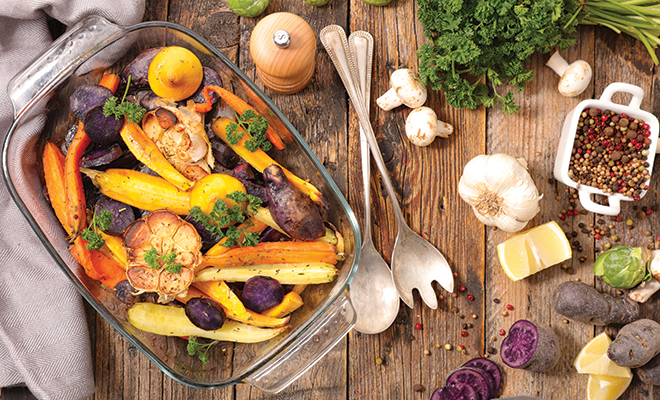
A Bounty of Winter Vegetables!
I have fond childhood memories of family gatherings at the supper table.
My mother was raised in a farm family; supper always featured meat, a green vegetable, a starchy vegetable and bread. For my dad, a meal was not a meal unless you served meat with two vegetables AND a salad, plus dessert. Anything less was just not acceptable.
The more significant the gathering, the more thought and effort were put into a menu. Holiday buffets seemed endless: Main dishes featured smoked turkey, roast baron of beef, bone-in ham. Side dishes of mashed potatoes and gravy, stuffing, green bean casserole, yams with marshmallows, and ambrosia salad with fresh fruit and coconut were next, followed by flaky, fresh-baked dinner rolls ready to be slathered with butter. Dinner was followed by dessert, a variety of pies topped with whipped cream, cheesecake or fruitcake with hard sauce. Oh, don’t forget the festivities that began the evening; warm and festive beverages such as eggnog or seasonal cocktails were the prelude to the feast.
Thinking back on those meals, when we all sat down to enough fat, sugar and carbohydrates the equivalent of what most people consume in one week, it’s a miracle that my family managed to survive the holiday season.
Now, the pendulum has swung in the opposite direction. Family or friends may be vegan, allergic to certain foods or have health issues. Sometimes it seems that the only safe menu option is lettuce leaves and a wedge of lemon! My answer to that is: always be up front about your menu plan. Make sure your guests aren’t surprised, and be gracious when people with dietary restrictions offer to bring a dish of their own.
But in the absence of any food preferences or food allergies, more and more people find plant-based dishes appealing. Let me be clear; I’m not talkin’ tofurkey here. It’s true; there are a lot of vegetarian dishes that mimic the taste and texture of meat entrees. But even the most meat-centric cooks love side dishes of flavorful greens and vegetables. Fall and winter bring on nature’s bounty, featuring root vegetables, simmered soups and sauces, hearty risottos and leafy greens. Any of these can easily accompany a meat entree or stand alone as a main course.
Whether you’re cooking for yourself, your family, a potluck or a sit-down holiday supper, vegetables can be the star of any meal. They’re also a healthy choice. Research shows that plant-based diets of fruit, vegetables and whole grains, with less meat, refined carbohydrates and sugars, have been proven to reduce the risk of heart disease. Let’s take a look at different ways you can make a plant-based diet work.
We’ll start with cooking for one person. I was recently inspired to follow the example of a friend who has embraced a healthy diet plan. Every weekend, Gailla preps enough veggies to fill two baking sheets–broccoli, cauliflower, peppers, asparagus, and sweet potatoes–whatever looks good at the grocery. The chopped veggies are popped in the oven on foil-lined baking sheets, drizzled with a little olive oil and seasoned with salt and pepper. Roast for about 30 minutes at 400 degrees and you’ll have enough veggies for a week’s worth of meals for lunch or dinner. Any leftovers can easily be frozen or tossed into a pot of soup, an omelet or mashed potatoes.
Communal meals require more thought and planning. If you’re hosting a dinner or pot luck, let your guests know what to expect. After you choose an entrée, select vegetable side dishes that complement one another. Hearty casseroles heavy on carbohydrates and fats, such as creamed corn and potatoes au gratin, can be paired with crisp green salads and crunchy raw vegetables. The dessert table can offer fresh grapes and winter fruit salads along with fresh-baked cakes and pies.
Winter meals might inspire roasted cauliflower or root vegetables, or baked squash with a hint of honey or maple syrup. This natural sweetness plays well with opposite flavors of sautéed chard or spinach, finished with a splash of astringent vinegar, perhaps balsamic or tarragon. These sweet and savory flavors provide a counterpoint to any entrée of meat, poultry or fish. Lighten things up with a winter salad of greens and radicchio, radish and bell peppers, multicolored beets, citrus fruit and goat cheese with a tangy vinaigrette. Dessert, anyone? Sauté some sliced apples, add raisins, nuts and a little brown sugar for the perfect end to the meal. Or put another log on the fire and serve port with English walnuts as the winter evening winds down.
Voilà! You’ve planned a meal with an entree, two vegetables and a salad! Plus dessert. That’s the kind of meal that made my dad happy. I think that you’ll find it pleasing as well. ■
Source: livescience.com.







